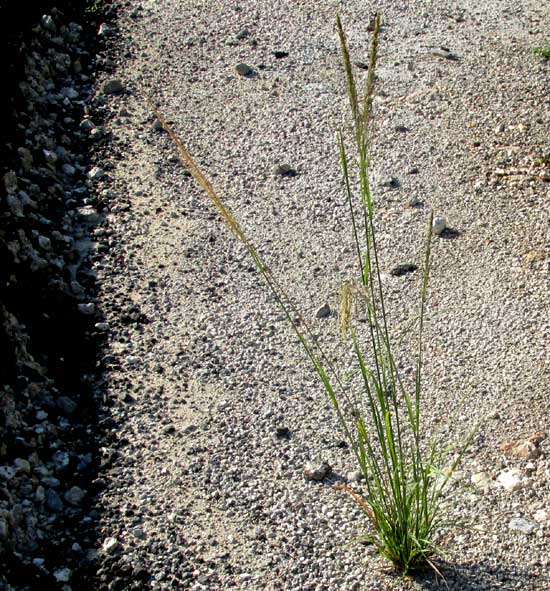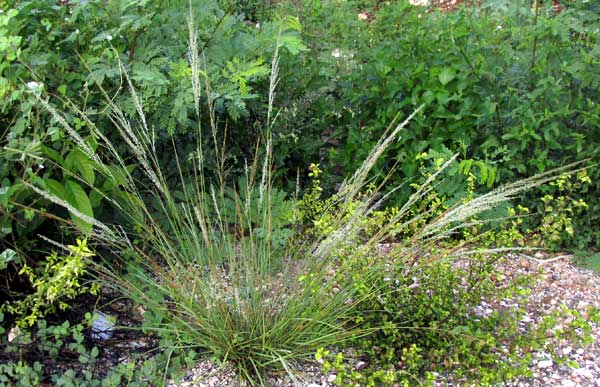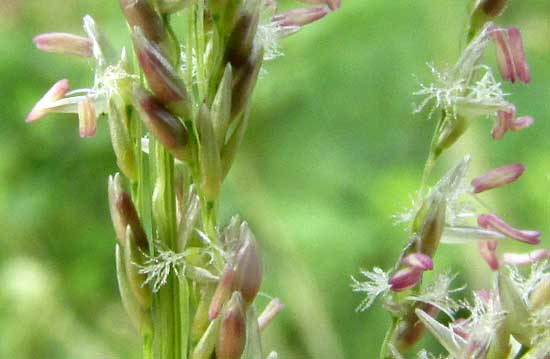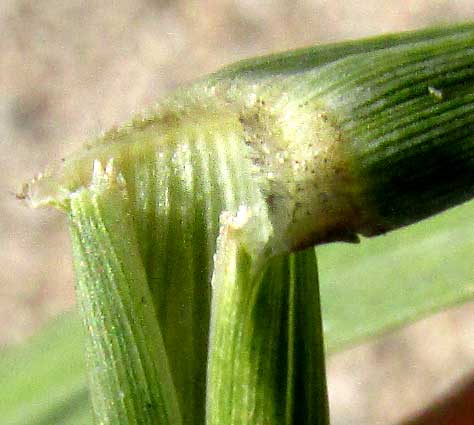Excerpts from Jim Conrad's
Naturalist Newsletter
from the July 24, 2016 Newsletter issued from Hacienda Chichen Resort beside Chichén Itzá Ruins; limestone bedrock; elevation ~39m (~128ft), N20.675°, W88.569°; central Yucatán state, MÉXICO
DROPSEED GRASS
On the road to Xcalacoop sunlight glared off the white limestone-gravel roadside, such a harsh environment that hardly anything grew there at all. A certain spindly looking grass caught my eye simply because it was surviving there, and had a form I couldn't quite place. I got off the bike and took its picture, so, below, you can see it right beside the asphalt, which shows up as a black frame at the picture's left:

The grass was past its peak flowering time, with most of its spikelets already fallen off. Still, important field marks could be noted, as shown below:

First of all, the thousands of kinds of grasses can be divided into two big groups: those whose spikelets contain just one flower, or floret, and those with more than one. If you can't visualize the difference, check out our Grass Page at www.backyardnature.net/fl_grass.htm
In the above picture our roadside species is clearly of the one-floret kind, so it's definitely not a bluegrass, not a fescue, or any of the other big grass groups whose spikelets bear more than one floret. Another good field mark is that the flowering head, or inflorescence, is of the panicle type, with divisions branching more than once. Also, note that here and there florets appear to have fallen away leaving scale-like glumes on their little stalks, or pedicels. When the florets of many kinds of grass fall, the glumes go with them, so this is a good field mark.
Then it was noticed that a little farther off the road the same species was growing much more lushly in its less deserty habitat, shown below:

That plant had florets still issuing pinkish, pollen-filled anthers and white, much branching styles, shown below:

One last feature to check before trying to ID the grass was the ligule, the rim-like structure at the blade's base where it meets the stem. Some grass kinds have ligules, some don't, and when they're present they come in a wonderfully diagnostic variety of forms. In the literature our grass's ligules are described as a fringe of hairs 0.2-0.3 mm long, which is what we see below:

Our roadside grass belongs to a large, well-known group called dropseeds, the genus Sporobolus. Several Sporobolus species are listed for the Yucatan, but the above field marks -- especially the panicle's narrowness and the short, hairy ligule -- leads us to SPOROBOLUS JACQUEMONTII, graced with a number of English names, including American Ratstail Grass, Giant Smutgrass, Smutgrass, West Indian Dropseed, West Indian Rush-grass, West Indies Smutgrass, and more.
It's native to most of tropical America and has become an invasive weed in much of the rest of the tropics. In Queensland, Australia it's listed as a Class 2 environmental weed, meaning that landowners must take all reasonable steps to keep land free of the species, and that it's illegal to sell it or its seeds.
Here Sporobolus jacquemontii is well behaved, not seeming aggressive at all, just occupying environments too harsh and sterile for other plants to root in. It's a good citizen doing its job to stabilize the soil and keep down erosion.